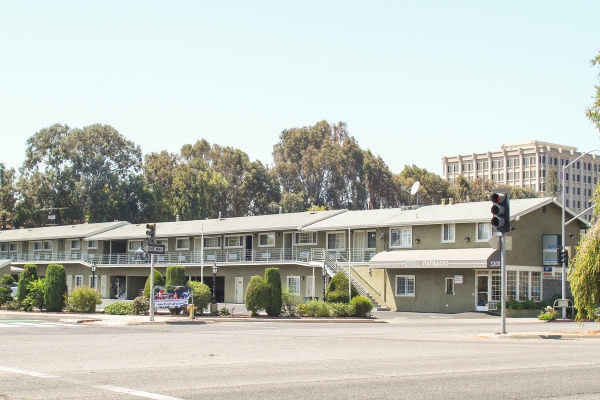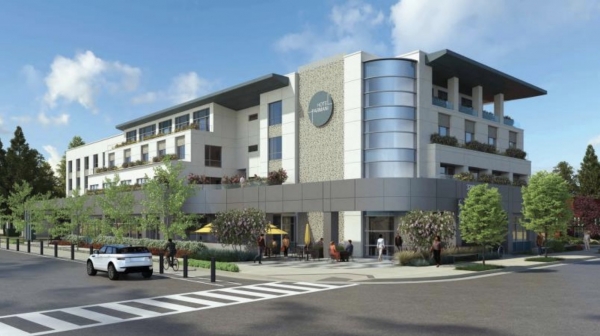Palo Alto paved the way on Monday night for the demolition of Hotel Parmani, a modest, 36-room motel on El Camino Real, and its reincarnation as a modern, 99-room hotel catering to Stanford Research Park clientele.
For project applicant Yatin Patel, the biggest setback for the application was, quite literally, the setback. In 1959, the city instituted a requirement for a 50-foot "special setback" that applies along the full length of the 100-foot-long property. The current motel, which was built 12 years before that rule change, intrudes 25 feet into the setback.
The council's unanimous vote will allow the Patel family to demolish the two-story motel and replace it with a four-story hotel that will also feature a corner plaza and a coffee shop. The Patel family estimates that the new development will bring the city about $1 million in annual hotel-tax revenues while providing rooms for visitors to the nearby Stanford Research Park.
"We think supplying high-quality rooms near where the demand is is smart land use for a project in the Research Park," Patel said. "We hope you agree the hotel creates a high-quality image of the city, of the high standards that are expected in the city."
Patel, whose family has operated the hotel for more than 30 years, told the council Monday that the rule effectively prohibits any type of redevelopment of the site, whether now or in the future. And neither he nor city planners could say why exactly the setback was created, though the city's project consultant, Sheldon Ah Sing, surmised that the council's intent at the time may have been to create a landscape buffer for Stanford Research Park.
Patel's family has been trying to get the setback removed for more than three years. The council had previously considered the project at two different hearings — in April 2016 and in May 2017 — and had indicated at those meetings that it would be willing to make the change.
It did just that on Monday night, voting to eliminate the setback requirement. In doing so, the council largely accepted Patel's argument that the restriction is unreasonable and unnecessary. In a letter to the council, Patel wrote that the existence of the "special setback" requirement on his site — which is physically outside Stanford Research Park — is an "anomalous condition" that may have been an "administrative error."
The Planning and Transportation Commission largely concurred at its Dec. 12 meeting, when it voted to eliminate the setback requirement. At the same time, the commission added a condition specifying that the waiver would only apply to hotel and mixed-use projects – not offices.
Patel took some issue with that recommendation and asked the council to reject it. In a letter to the council, Patel noted that setback requirements typically get applied "uniformly within each zoning district regardless of use."
"Do we want City Council to constantly referee the applicability of the special setback restriction based on land use?" Patel wrote. "Removing the setback restriction permanently streamlines the process, removes any clouds of uncertainty for anyone in the future and spares staff from potentially revisiting the issue again decades from now."
The council, however, sided with the planning commission and supported Councilman Tom DuBois' motion, which included the restriction on land uses.
The only issue that generated some debate was the proposed elimination of the "pork chop" island at the El Camino and Hansen Way intersection. The removal of the pork chop, which enables "free right turns" from El Camino to Hansen, was proposed by planning staff as part of an effort to improve pedestrian and bicycle movement through the intersection. DuBois, however, argued that this move may hinder the flow of car traffic at the congested segment of El Camino.
"There's not a lot of biking there today; there's quite a lot of vehicular traffic," DuBois said.
He called that part of the thoroughfare a "tricky place," with two traffic lights close together.
"I think cars are going to be slowed down by those lights already," DuBois said. "Losing the ability to get in and out of the Research Park is my primary concern."
DuBois recommended that staff retain a design with a dedicated right turn for vehicles, with or without the pork chop. Vice Mayor Adrian Fine noted that the removal of the pork chop was identified as a safety improvement by transportation staff and called the proposal "completely reasonable."
The council's vote did not propose any particular redesign for the intersection and did not specify whether the pork chop should be retained. The motion, which won unanimous approval, only directed staff to "maintain the right turn capacity in an appropriate design," as determined by staff working with the state Department of Transportation.




Comments
University South
on Apr 2, 2019 at 9:47 am
on Apr 2, 2019 at 9:47 am
When will it happen?
That's going to be nice.
Registered user
Crescent Park
on Apr 2, 2019 at 11:07 am
Registered user
on Apr 2, 2019 at 11:07 am
And, this is why the state is pushing for SB50. What happened to Eric Filseth's dramatically presented proclamation that there can be no new development! no new jobs! without one housing unit for each job!? The City just allowed a 36 room hotel to expand to a 99 room hotel. That will absolutely require more employees. And, not highly paid tech employees. The County and the City both want Stanford to house all employees associated with their proposed growth. Shouldn't the hotel have to provide housing for the new employees they will need?
Barron Park
on Apr 2, 2019 at 12:09 pm
on Apr 2, 2019 at 12:09 pm
The 50' setback seemed completely arbitrary on this parcel, and this seems like a massive upgrade compared to the current motel. This intersection is definitely crazy for cyclists and pedestrians alike right now and removing the pork chop island seems reasonable.
Registered user
Crescent Park
on Apr 2, 2019 at 1:17 pm
Registered user
on Apr 2, 2019 at 1:17 pm
@PatrickD. Completely agree the setback was arbitrary and eliminating the triangle is a good thing. And overall, this is a good project. But how can Palo Altans complain about SB50 and the State wanting to force more density when the City keeps approving more business expansion without the needed housing for those ees? We can’t have it both ways.
Registered user
Duveneck/St. Francis
on Apr 2, 2019 at 1:49 pm
Registered user
on Apr 2, 2019 at 1:49 pm
I would love to see the city require that the architectural drawings for proposed projects be realistic. A few examples:
1) Will this project include the barriers between cars and bikes along Hansen as is shown in the rendering? What about the new landscaping along Hansen?
2) No traffic lights shown
3) Palo Alto Square is no longer visible. Even at that angle, PA Square can be seen in real life.
If reality matches the renderings, it will be a nice improvement.